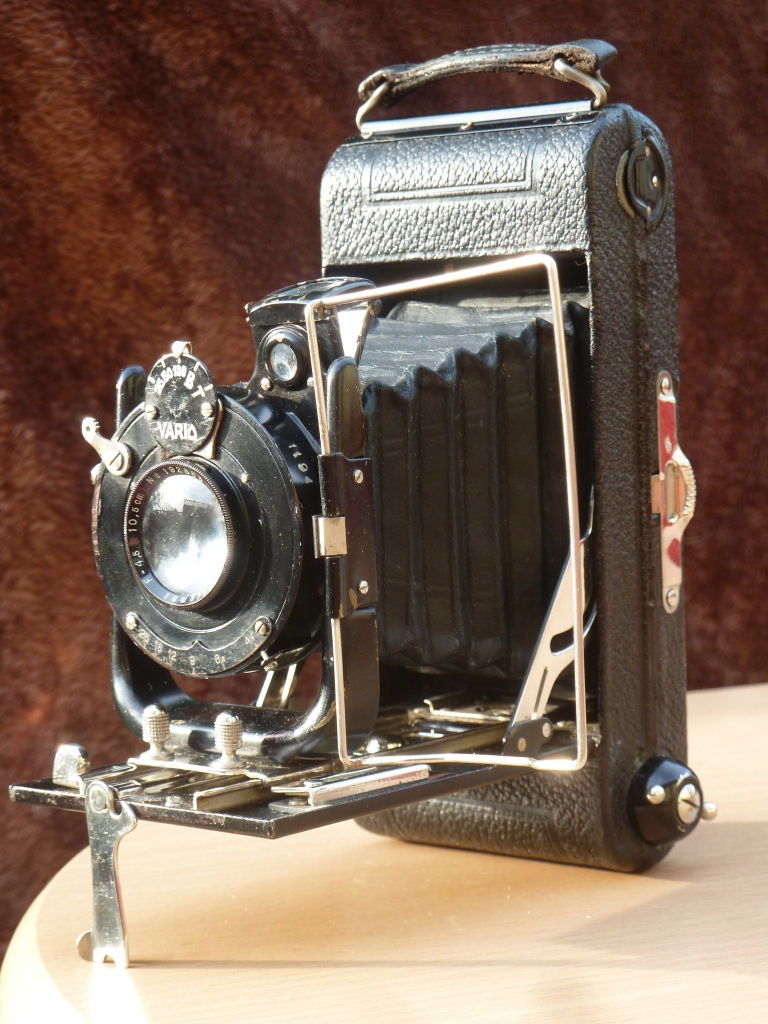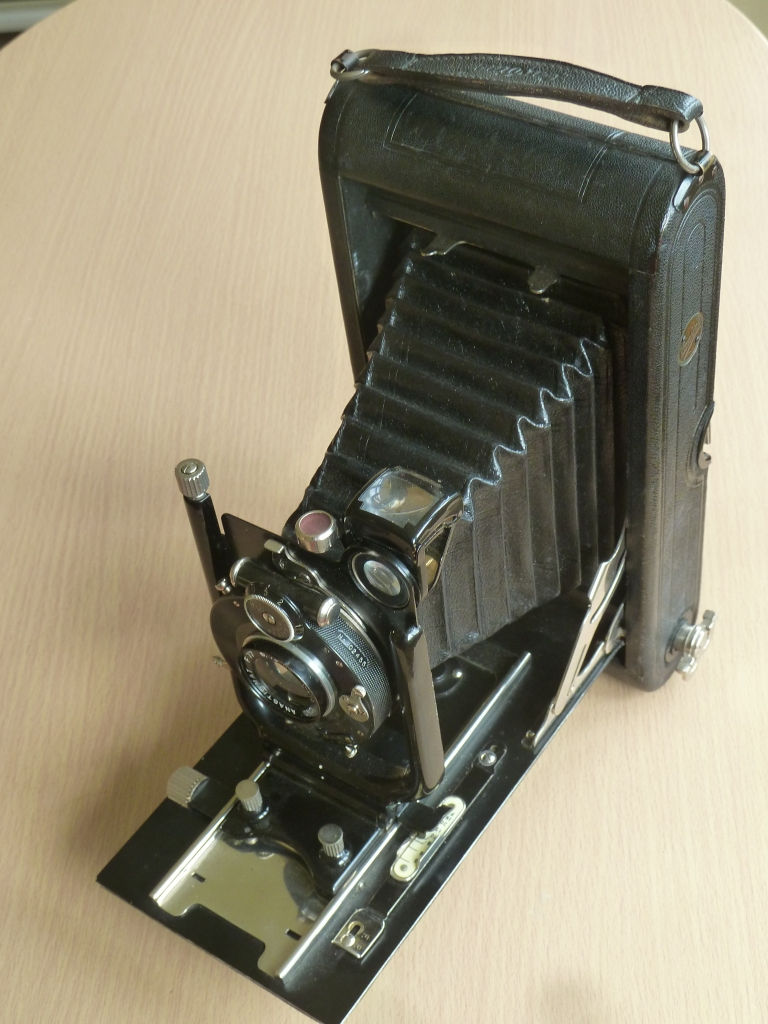Ensign Auto-Range 20
- Kamera Ostalgie

- Jun 7
- 6 min read
Updated: Sep 20
A high quality English Rangefinder folding camera from the mid 1930's

My many regular readers, all eight of them, will know that I'm currently searching for my Weltaflex TLR to do a review and put a film through it for the blog. Whilst searching the attic once again for the elusive TLR from the GDR, I found this ! I know, it is not German or a TLR, its English and its an Ensign! Or is it ?

As you have probably realised, I do like Ensign Cameras, when I was much younger I collected quite a few different models, this one is quite unusual, having a rangefinder, quite a modern feature for its time and a rising & falling front and a cross front, both very old features for a modern rangefinder camera in the mid 1930's. In fact the Ensign Auto-Range 20 must have been a little strange even when it came out in 1934.

Looking at it from this view it looks like a folding camera from the 1920's or earlier with its pull out front on rails and folding wire direct viewfinder. It must have looked very dated even in 1934! It is nearly like the top brass at Houghton-Butcher were looking at the rangefinder cameras coming out of Germany, especially Zeiss Ikons Super Ikontas and thought, oh we need a folding rangefinder camera to put into production quickly, but we have no time or funds to design one from scratch, so lets just fit a coupled rangefinder to that old 6x9 folder we no longer make, that should do the trick!

I bet the gentlemen in Dresden were chocking on their Apple strudle and custard when they saw this in the 1934 Ensign Catalogue! It was no competition for the competition really. Having said that, the Auto-Range 20 was still a good camera and was a big improvement to most folding cameras on the market that had no rangefinder at all, but it took them till 1937 to produce the Ensign Auto-Range 220, which looked much more modern and was a design that could really compete with the Super Ikonta and the like.

Lets not knock the Auto-Range 20 too much. Despite its dated looks this was a serious photographic tool in 1934. Look at its features, rising and falling front, cross front, radial focus lever on the camera bed, coupled rangefinder, brilliant finder and a wire direct finder, adjustable diopter view finder, 100mm Ensar f4.5 lens shutter speeds of T, B, 1, 1/2, 1/5, 1/10, 1/12, 1/50, 1/100th of a second with apertures of f4.5, 5.6, 8, 11, 16, and 22. It would give you 8 large 6x9 negatives on a E20 Ensign film! (Kodak 120) This was a good specification and it was not cheap either at around £7-10-0d, which was a lot of money in 1934, way out of reach of most people.

Look at that aperture control lever, you have the lever which sticks up so it is easy to move and the pointer with which you read off the aperture is to the right of the lever, that's engineering, it's design! It works well in practice

.The rising and falling front, a lovely feature, but maybe just a leftover from folding plate camera days? Maybe you could get a plate back for them like on earlier Butchers Carbines?

The lever sticking out of the camera bed is the focussing lever, the little round wheel is the side swing or cross front as it is sometimes known.

A nice clear focussing scale in metres and feet, but again this is a feature from a decade or two before. Oh this is a strange camera, in 1934 this must have been modern and ancient at the same time. Or am I just missing something, not getting the point? I'm not sure.

English Patent number 415770 must relate to the focussing method where these arms move the lens standard back and forth on the tramline rails.

There are so many nice touches to this camera, some mainly cosmetic some functional. This strap won't break like the plain leather ones, this is one solid camera handle.

Even the red window cover is a work of art.

The double hinge feature for the camera back is a typical example of great design, Ensign were still using the double hinge idea 20 years later.

The Ensign name sat proudly on top of the rangefinder body. But just look at that picture and study it, the heavily embossed slightly dark brown leather covering is typical of the 1920's and before, but the matt black crackle finish of the Rangefinder, bang up to date mid 1930's finish! Something here is odd. They don't go together at all.

And on the body number plate. The number here is H23244. Very 1920's Butchers in style.

And again embossed in the leather on the camera back. Ensign were very proud of this camera, and proud that it was made in England.

They even put the name on the high quality leather camera case!

It carries patent numbers for England, the United States and Germany. I wonder if this sold well in Germany. Maybe it did? You could buy it with a Zeiss Tessar lens and in a Prontor or Compur shutter instead of the British Mulchro shutter fitted to my example. Now that would be quite a version, with a Tessar lens and a Compur shutter!

I'm quite happy with my Mulchro shutter example though, it still works on all speeds and sounds as sweet as anything 90 years after it was made. You really can't get better than that!

They really must have pushed the German market looking at these patent numbers. I wish I could find out how well it sold in 1930's Germany. They did produce a version called the Auto-Range 20 'Super Speed' with a 3.8 Tessar in a Compur Rapid shutter. That must have been some camera. But it is still an oddball like it's from two different decades.

There was even a version with a Focal Plane Shutter, though I have never seen one in the flesh!

Infact there are so many slightly different versions of the Ensign Auto-Range - 20, you could collect nothing else! Every one that comes up for sale is seems slightly different!
On ebay at the moment is one badged as a No7 Ensign Carbine Auto-Range, it looks identical to my version apart from the badging on the camera bed, oh and it is missing the focus lever. It is priced at £60. It is a new one to me. G 23016 is the body number, most Autoranges are H...... not G? Hmm.
Also on ebay a slightly tatty one at £29, which has a German Prontor II shutter and a completely different camera back
MW Cameras have one at £59, all slightly different ! All interesting stuff !

So to conclude this little ramble, I have a theory, as yet no proof, but I think these Ensign Auto-Ranges were a quick stop gap camera based on an old Butchers Carbine model of the 1920's with a new modern Rangefinder attached. I'm going to go one step further, I think they were built in Germany hence the German Patents and optional German lenses and shutters, or at the very least assembled in England using German parts. Maybe someone had a load of 1920's bodies that were never used? ICA perhaps! Close ties to Butchers in the past, even made their cameras! See this blog !
kameraostalgie.blog/2025/05/04/buthers-famous-watch-pocket-carbine/

Everything points to it, the 1920's shape and styling, the pull out front on rails, the rising and falling front and cross swing, I mean that's from another age, and without a ground glass focussing screen not much use as you would not be able to see the effect of the rise and fall and the swing, it would just be a rough guess as to what you would get on your film. Maybe you could get plate backs for them? Also the German Patents, why, this would never be a serious competitor to a Super Ikonta, it would not stand a chance. Also the Rangefinder just looks like an after thought screwed on! The leather finish looks a decade older than the crackle black rangefinder finish, It looks like the leather finish of a 1920's ICA camera, exactly the same grain!
What do you think ? I'm going to do a bit more digging, see if I can prove my theory !
The number 7 Butchers Carbine on Ebay nearly proves it, I just need a few more links !
Whatever the true story the Ensign Auto-range is a really nice camera!

Take care,
Phil

P.S. Just found this picture of a 1914 Butchers Carbine camera. Does the back remind you of anything ?



